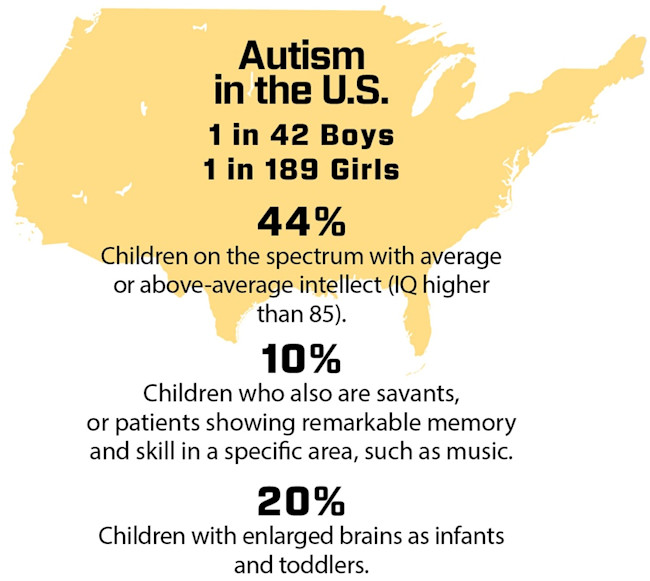Are You One Of 3 Million Brits With Autism Or ADHD? Understanding The Spectrum

Table of Contents
The Prevalence of Autism and ADHD in the UK
Statistics on Autism in Britain
Autism affects a significant portion of the UK population. While precise figures vary depending on the study and diagnostic criteria used, estimates suggest that around 1 in 100 people in the UK are diagnosed with autism. This translates to hundreds of thousands of children and adults. However, the actual number is likely much higher. Recent studies and reports from organizations like the National Autistic Society highlight significant underdiagnosis rates, particularly in adults.
- Underdiagnosis in Adults: It's estimated that a substantial number of adults in the UK remain undiagnosed with autism, potentially impacting their access to support and understanding. Many adults only receive a diagnosis after seeking help for other issues.
- Challenges in Diagnosis: Variability in diagnostic practices and a lack of awareness contribute to underdiagnosis. This necessitates a greater focus on improving access to diagnostic services and raising public awareness.
Statistics on ADHD in Britain
Similarly, ADHD is another prevalent neurodevelopmental condition in the UK. The estimated prevalence is around 2-5% of children and a similar proportion of adults, though diagnosis rates vary considerably. This means potentially millions of individuals in the UK are affected.
- Gender Disparity: There's a notable gender disparity in ADHD diagnosis rates, with boys significantly more likely to be diagnosed than girls. This highlights potential biases in diagnostic practices and the need for improved awareness and screening for girls and women.
- Increasing Adult Diagnosis: There's a growing awareness of ADHD in adults, leading to more individuals seeking diagnosis and support in recent years. This increased awareness has highlighted the significant impact ADHD can have throughout life.
- Support Services: While many individuals receive ADHD support, access to appropriate therapies and interventions varies across the UK, with significant regional differences.
Understanding the Spectrum: Common Symptoms of Autism
Social Communication Challenges
Individuals with autism often experience challenges in social communication and interaction. This can manifest as:
- Difficulty initiating or maintaining conversations: Struggling to start or continue conversations, especially with unfamiliar people.
- Misinterpreting social cues: Having trouble understanding non-verbal communication like body language, facial expressions, or tone of voice.
- Limited understanding of social reciprocity: Difficulty engaging in back-and-forth interactions or sharing emotional experiences with others.
These challenges can impact relationships, friendships, and participation in social settings. Improving social skills is a key focus of many autism interventions.
Repetitive Behaviors and Restricted Interests
Many individuals with autism exhibit repetitive behaviors, routines, and restricted or fixated interests. These can include:
- Repetitive motor mannerisms (stimming): Actions like hand-flapping, rocking, or repetitive movements which can provide self-regulation.
- Insistence on routines: A strong need to follow specific routines and schedules, becoming distressed if disrupted.
- Fixated interests: Intense and focused interest in specific topics or objects, often to the exclusion of other activities.
These behaviors can be crucial for self-regulation and comfort but can also cause challenges in adapting to new situations.
Sensory Sensitivities
Sensory sensitivities are common in autism, affecting the way individuals experience sensory input from their environment. This might involve:
- Oversensitivity: Extreme reactions to sounds, light, touch, tastes, or smells. Loud noises might be overwhelmingly painful, bright lights unbearable.
- Undersensitivity: A reduced awareness or response to sensory stimuli. This could mean needing intense sensory input to feel fully alert or engaged.
Understanding and managing sensory sensitivities is vital for improving quality of life and reducing anxiety.
Understanding the Spectrum: Common Symptoms of ADHD
Inattention
Inattention is a core symptom of ADHD, affecting the ability to focus and concentrate. This can lead to:
- Distractibility: Easily distracted by internal or external stimuli, struggling to stay on task.
- Difficulty focusing: Struggling to maintain attention on tasks or conversations, even when they're interesting.
- Forgetfulness: Frequently forgetting appointments, tasks, or important information.
These challenges can affect academic performance, work productivity, and daily responsibilities.
Hyperactivity and Impulsivity
Hyperactivity and impulsivity are other key symptoms of ADHD. Hyperactivity might include:
- Fidgeting and restlessness: Inability to sit still, constant movement, and restlessness.
- Excessive talking: Interrupting conversations frequently and talking excessively.
Impulsivity can manifest as:
- Acting without thinking: Making hasty decisions without considering consequences.
- Difficulty waiting: Struggling to wait their turn or delay gratification.
These behaviors can lead to social difficulties, accidents, and challenges in managing daily life.
ADHD Subtypes
ADHD is categorized into three subtypes: predominantly inattentive, predominantly hyperactive-impulsive, and combined. The combined type displays significant symptoms of both inattention and hyperactivity/impulsivity.
Seeking Diagnosis and Support for Autism and ADHD in the UK
The Diagnostic Process
Getting a diagnosis involves a multi-step process. This typically includes:
- Referral: Starting with a referral from a GP or other healthcare professional.
- Assessments: Undergoing comprehensive assessments by specialists like psychologists, psychiatrists, or paediatricians. These might involve questionnaires, interviews, and observation.
Available Support and Therapies
The UK offers a range of support services for individuals with autism and ADHD, including:
- Educational support: Specialized educational programs and support in schools and colleges.
- Therapy: Various therapeutic approaches such as Cognitive Behavioral Therapy (CBT), occupational therapy, and speech and language therapy.
- Medication: Medication can be helpful in managing some symptoms of ADHD, particularly hyperactivity and impulsivity.
- Support groups: Support groups and charities like the National Autistic Society and ADHD UK provide valuable resources and peer support.
Accessing these services can vary depending on location and individual needs.
Conclusion
This article highlighted the significant number of individuals in the UK living with autism or ADHD, many of whom remain undiagnosed. Understanding the spectrum of symptoms for both conditions is vital for early intervention and access to appropriate support. If you suspect you or a loved one may have autism or ADHD, don't hesitate to seek professional help. Early diagnosis can make a profound difference in managing symptoms and improving quality of life. Take the first step towards understanding and managing Autism and ADHD in the UK today. Contact your GP or a specialist for further information and support.

Featured Posts
-
 High Stock Valuations A Bof A Perspective For Investors
May 13, 2025
High Stock Valuations A Bof A Perspective For Investors
May 13, 2025 -
 Flushed Away Comparing It To Other Aardman Animations
May 13, 2025
Flushed Away Comparing It To Other Aardman Animations
May 13, 2025 -
 2024 Senior Events Calendar Trips And Activities
May 13, 2025
2024 Senior Events Calendar Trips And Activities
May 13, 2025 -
 Did You Shoot Someone In Self Defense Understanding Self Defense Insurance
May 13, 2025
Did You Shoot Someone In Self Defense Understanding Self Defense Insurance
May 13, 2025 -
 India Pakistan Tensions Ease A Delicate Ceasefire Holds
May 13, 2025
India Pakistan Tensions Ease A Delicate Ceasefire Holds
May 13, 2025
